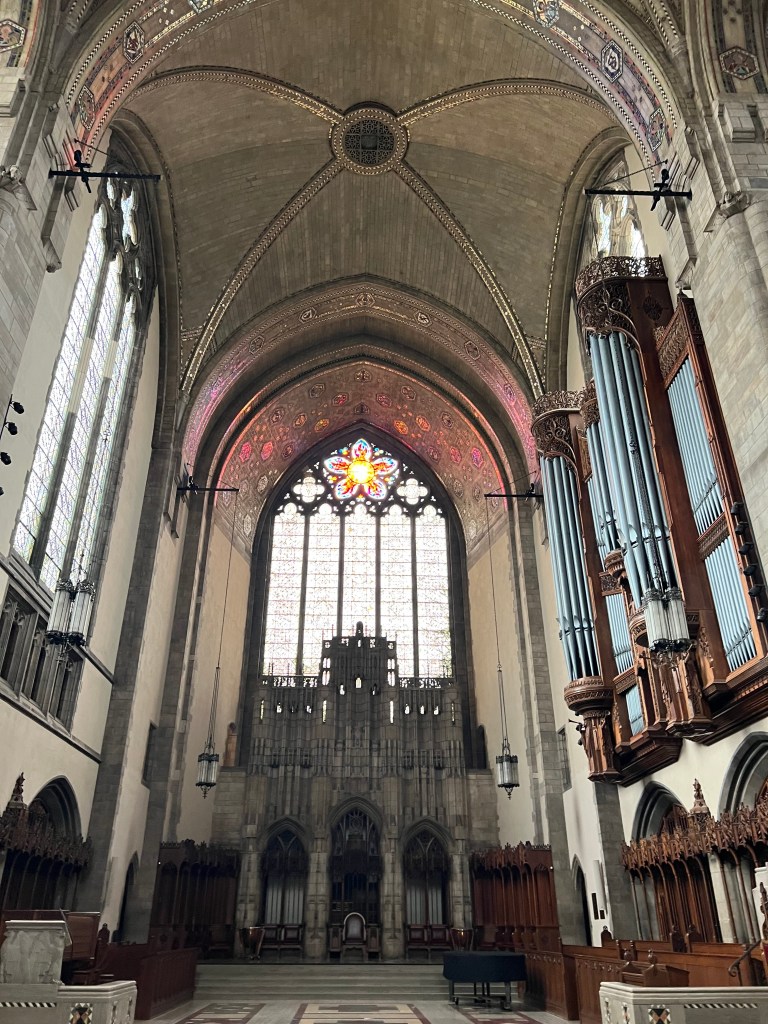
My son attended the University of Chicago. We both like visiting Hyde Park so we took a trip to have a meal at Medici’s (a salmon burger for me) and a walk around campus. Toward the end of our wanderings we walked through the University Chapel, one of the largest such institutional structures in the United States.
I picked up one of the plain brochures documenting the history and features of the Chapel that was originally funded by more than $34M in contributions from John D. Rockefeller. The structure was completed in 1928, one year before the collapse of the economy and the beginning of the Great Depression.
I’ve visited one other great cathedral the size of the University Chapel. That was in Barcelona, Spain, where we toured the Sagrada Familia Basilica constructed under the guidance of Antonio Gaudí. As I wrote in my recently published book, the theology behind Gaudi’s architecture unifies spiritual concepts of God with representations of creation.

“The Spanish words “sagrada familia” mean ‘sacred family.’ That concept is the central motif across the many tall towers forming the Sagrada Familia basilica in Barcelona, Spain. Construction of the massive structure began more than a century ago. It is scheduled for completion in the year 2026. That culminates the plans originated by late Spanish architect Antonio Gaudí, whose organic style of architecture fuses symbols of Creation’s glory with God’s spiritual transcendence as symbolized through the Sacred Family.
“A time.com2 article describes how Gaudí developed his masterwork, explaining that the architect had a grand concept in mind: “It didn’t take him long, however, to transform the Sagrada Familia’s original plans into an extraordinarily ambitious undertaking: a structure that would combine natural forms and Christian symbolism into a temple that, as Faulí puts it, “expressed meaning not only through the sculpture and other decorations but through the architecture itself.” Gaudí was not a practicing Catholic when he received the assignment. But he became increasingly devout as he worked on it, eventually coming to see the very structure as a vehicle for Christian evangelism.”
The relationship between God and creation goes into even deeper symbolism, as expressed in a piece written about the basilica on a travel website:

“An earnest and down-to-earth description on the website Culture Trip outlines the practical aspects of its design: “The central tower in the middle will reach 170 meters tall. Despite having a powerful height, Gaudí believed that nothing human-made should ever be higher than God’s work. It is no coincidence that the ultimate height will be one meter less than Montjuïc, the mountain in Barcelona, which is also the city’s highest point. There are tons of symbolism in each part of Gaudí’s structure. Aside from the religious symbols, there are two you should look out for. First, the interior pillars resemble trees, and when you look up at them, their shapes constantly change, as real trees appear to do. There is also a tortoise and turtle holding up these pillars, representing both the earth and the sea.”

Having previously absorbed the wondrous symbolism of Sagrada Familia, I was struck by the parallels found in the University Chapel. There are many sculptures of holy figures including apostles and prophets along with heroes and heroines of faith. “The whole design suggests the march of religion through the centuries,” the Chapel brochure documents.
There are also statues of political figures and coats of arms from major state and private universities in America and around the world. These secular representations meld the academic legacies of the college to other forms of philosophy, especially science, demifigures of the Poet, the Thinker, the Merchant, the Craftsman, the Builder, and the Teacher, “since the work of all is, in the broad and deep sense, religious.”
“Demifigures of Faith and Love flank the upper windows,” it is explained, “The birds of wisdom and of Inspiration, the owl and the eagle, appear near the top.”
Along the ribs of the Chapel are fourteen subjects; as noted: “Bird, Beast, Fish, Reptile, Sun, Moon, Star, Tree, Flower, Man, Earth, Air, Water, Fire, which, as the objects of man’s study, reveal God.”
Such wonderful parallels exist between these two great expressions of spiritual and intellectual enlightenment. The University Chapel and Sagrada Familia potently remind us that while many seek the halls of heaven in the great beyond, the presence and reality of God is best known through our daily and organic encounters with life, while we live it.
This article contains excerpts from Christopher Cudworth’s new book Honest-To-Goodness: Why Christianity Needs a Reality Check and How to Make It Happen.

